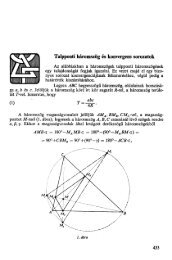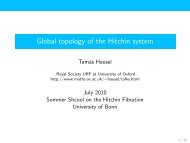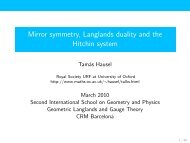Mirror symmetry in the character table of SL_n(F_q) - GEOM - EPFL
Mirror symmetry in the character table of SL_n(F_q) - GEOM - EPFL
Mirror symmetry in the character table of SL_n(F_q) - GEOM - EPFL
Create successful ePaper yourself
Turn your PDF publications into a flip-book with our unique Google optimized e-Paper software.
<strong>Mirror</strong> <strong>symmetry</strong> <strong>in</strong> <strong>the</strong> <strong>character</strong> <strong>table</strong> <strong>of</strong><br />
<strong>SL</strong>n(Fq)<br />
jo<strong>in</strong>t work with M. Mereb and F. R. Villegas<br />
Tamás Hausel<br />
Chair <strong>of</strong> Geometry, EPF Lausanne<br />
http://geom.epfl.ch/Hausel/talks<br />
De la géométrie algébrique aux formes automorphes :<br />
une conférence en l’honneur de Gérard Laumon<br />
Université Paris-Sud, Orsay<br />
29 June 2012<br />
1 / 15
Quote from (Atiyah 2004)<br />
”I would like to make a rash prediction that ideas from physics<br />
will have a big impact on number <strong>the</strong>ory as <strong>the</strong> ideas flow<br />
across ma<strong>the</strong>matics - on one extreme number <strong>the</strong>ory, on <strong>the</strong><br />
o<strong>the</strong>r physics, and <strong>in</strong> <strong>the</strong> middle geometry: <strong>the</strong> w<strong>in</strong>d is<br />
blow<strong>in</strong>g, and it will eventually reach to <strong>the</strong> far<strong>the</strong>st extremities<br />
<strong>of</strong> number <strong>the</strong>ory and give us a new po<strong>in</strong>t <strong>of</strong> view.”<br />
2 / 15
Cartoon I<br />
∇ · E = 0 ∇ · B = 0<br />
Maxwell’s equations:<br />
∇ × E = − ∂B<br />
∂E<br />
∂t ∇ × B = ∂t<br />
electro-magnetic duality: (E, B) ↔ (B, −E)<br />
⇓<br />
S-duality for N = 4 SUSY Yang–Mills gauge groups G and G L<br />
(Montonen–Olive 1977)<br />
⇓<br />
MDol<br />
T-duality between σ-models with target MHitch<strong>in</strong> MDR<br />
MB<br />
(Bershadsky–Johanssen–Sadov–Vafa 1995)<br />
⇓<br />
3 / 15
Cartoon II<br />
(Strom<strong>in</strong>ger–Yau–Zaslow 1996) mirror <strong>symmetry</strong> for<br />
MDol(G)<br />
MDol(G<br />
<br />
<br />
χG <br />
<br />
L )<br />
χGL <br />
A<br />
(Hausel–Thaddeus 2003; Donagi–Pantev 2006 )<br />
⇓<br />
Homological mirror <strong>symmetry</strong> = Geometric Langlands<br />
D b (Coh(MDR(G))) ∼ D b (Fuk(MDR(G L )))<br />
(Kontsevich 1994; Laumon 1987)<br />
(Beil<strong>in</strong>son–Dr<strong>in</strong>feld 1995; Kapust<strong>in</strong>–Witten 2007)<br />
⇓<br />
semi-classical limit fiberwise Fourier-Mukai transform<br />
D b (Coh(MDol(G))) ∼ D b (Coh(MDol(G L )))<br />
(Ar<strong>in</strong>k<strong>in</strong> 2002, Donagi–Pantev 2009)<br />
⇓<br />
4 / 15
Cartoon III<br />
cohomological shadow <strong>of</strong> fiberwise Fourier–Mukai transform<br />
H ∗ str (MDol(G)) H ∗ str (MDol(G L ))<br />
(Hausel–Thaddeus 2003; Ngô 2010)<br />
⇓<br />
P = W conjecture <strong>of</strong> (de Cataldo–Hausel–Miglior<strong>in</strong>i, 2012) <br />
H ∗ str (MB(G)) H ∗ str (MB(G L ))<br />
(Hausel–Villegas 2004)<br />
⇓<br />
Frobenius formula identities <strong>in</strong> Irr(G(Fq)) and Irr(G L (Fq)) <br />
#str(MB(G)(Fq)) = #str(MB(G L )(Fq))<br />
(Hausel–Mereb–Villegas 2012)<br />
5 / 15
<strong>SL</strong>n & PGLn Higgs moduli spaces<br />
C smooth projective curve; G = <strong>SL</strong>n G L = PGLn; Λ ∈ Pic d (C)<br />
Λ-twisted <strong>SL</strong>n Higgs bundle (E, φ)<br />
φ ∈ H 0 (C; End0(E) ⊗ K) and det(E) = Λ<br />
MDol(<strong>SL</strong>n) moduli <strong>of</strong> semi-s<strong>table</strong> Λ-twisted <strong>SL</strong>n Higgs bundles<br />
(n, d) = 1 ⇒ MDol(<strong>SL</strong>n) non-s<strong>in</strong>gular quasi-projective<br />
Γ := Jac(C)[n] (Z/nZ) 2g acts by: (E, φ) ↦→ (E ⊗ L, φ)<br />
PGLn Higgs moduli space is <strong>the</strong> orbifold:<br />
MDol(PGLn) := MDol(<strong>SL</strong>n)/Γ<br />
6 / 15
Hitch<strong>in</strong> map and SYZ<br />
Hitch<strong>in</strong> map: χ<strong>SL</strong>n : MDol(<strong>SL</strong>n) → A := n<br />
i=2 H0 (C; K i )<br />
(E, φ) ↦→ charpol(φ)<br />
Theorem (Hitch<strong>in</strong> 1987,1989; Nitsure 1991; Falt<strong>in</strong>gs 1993)<br />
χ<strong>SL</strong>n<br />
is proper completely <strong>in</strong>tegrable system.<br />
Theorem (Hausel–Thaddeus 2003)<br />
MDol(<strong>SL</strong>n)<br />
MDol(PGLn)<br />
<br />
<br />
χ<strong>SL</strong>n<br />
<br />
χPGLn<br />
<br />
<br />
A<br />
satisfies (Strom<strong>in</strong>ger-Yau-Zaslow 1996) for mirror <strong>symmetry</strong>.<br />
7 / 15
Topological mirror <strong>symmetry</strong><br />
Conjecture (Hausel-Thaddeus 2003)<br />
H∗ str (MDol(<strong>SL</strong>n); Q) H∗ str,B (MDol(PGLn); Q)<br />
<br />
<br />
κ∈ˆΓ H∗ (MDol(<strong>SL</strong>n); Q)κ <br />
γ∈Γ H∗−codimMγ<br />
Results:<br />
n = 2, 3 by (Hausel, Thaddeus 2003)<br />
for all n <strong>in</strong> <strong>the</strong> middle degree ∗ = MDol(<strong>SL</strong>n)<br />
by (Garcia-Prada–He<strong>in</strong>loth–Schmidt, 2010)<br />
us<strong>in</strong>g (Laumon, 1987)<br />
for all n up to degree ∗ < m<strong>in</strong>γ∈Γ∗ codimMγ<br />
by (Hausel–Pauly 2012)<br />
us<strong>in</strong>g symmetries <strong>of</strong> Hitch<strong>in</strong> fibers (Ngô, 2006)<br />
(MDol(<strong>SL</strong>n) γ /Γ, L B γ )<br />
8 / 15
Perverse filtration<br />
for any proper map f : X → Y (de Cataldo-Miglior<strong>in</strong>i 2005)<br />
<strong>in</strong>troduce perverse filtration ⊂ Pi ⊂ Pi+1 ⊂ . . . Pk H k (X)<br />
from <strong>the</strong> study <strong>of</strong> <strong>the</strong> Beil<strong>in</strong>son-Bernste<strong>in</strong>-Deligne-Gabber<br />
decomposition <strong>the</strong>orem for f!(QX) <strong>in</strong>to perverse sheaves<br />
extend<strong>in</strong>g <strong>the</strong> geometric fundamental lemma <strong>of</strong> (Ngô, 2010)<br />
from Aell over A <br />
Conjecture (Ref<strong>in</strong>ed topological mirror test)<br />
Under <strong>the</strong> Weil pair<strong>in</strong>g Γ ∗ Γ given by κ ↔ γ<br />
Gr P<br />
k H∗ (MDol(<strong>SL</strong>n))κ Gr P<br />
k− F(γ) H<br />
2<br />
∗−F(γ) (MDol(<strong>SL</strong>n) γ /Γ, L B γ )<br />
9 / 15
Character varieties<br />
<strong>the</strong> <strong>SL</strong>n-<strong>character</strong> variety:<br />
MB(<strong>SL</strong>n) := {(Ai, Bi)i=1..g ∈ <strong>SL</strong> 2g<br />
n | [A1, B1] . . . [Ag, Bg] = ζ d n In}//PGLn<br />
non-s<strong>in</strong>gular, aff<strong>in</strong>e<br />
for PGLn note that Γ (Zn) 2g acts on MB(<strong>SL</strong>n)<br />
MB(PGLn) := MB(<strong>SL</strong>n)/Γ<br />
Theorem (Non-Abelian Hodge Theorem; Simpson, Corlette)<br />
MDol<br />
diff<br />
MB<br />
10 / 15
P = W and Betti <strong>Mirror</strong> Symmetry<br />
Conjecture (”P=W”, de Cataldo-Hausel-Miglior<strong>in</strong>i 2012)<br />
Pk (MDol) W2k (MB) under <strong>the</strong> isomorphism<br />
H ∗ (MDol) H ∗ (MB) from non-Abelian Hodge <strong>the</strong>ory.<br />
Conjecture (Hausel–Villegas 2004)<br />
Under <strong>the</strong> Weil pair<strong>in</strong>g Γ ∗ Γ given by κ ↔ γ<br />
Gr W<br />
k H∗ (MB(<strong>SL</strong>n))κ Gr W<br />
2k−F(γ) H∗−F(γ) (MB(<strong>SL</strong>n) γ /Γ, L B γ )<br />
<strong>in</strong> particular<br />
Eκ(MB(<strong>SL</strong>n)) :=<br />
<br />
<br />
<br />
E(MB(<strong>SL</strong>n) γ /Γ, L B γ )q F(γ) =<br />
k,i<br />
i,k<br />
|Gr W<br />
k Hi (MB(<strong>SL</strong>n))κ|q k (−1) i<br />
|Gr W<br />
2k Hi (MB(<strong>SL</strong>n) γ /Γ, L B γ )|q k+F(γ) (−1) i<br />
11 / 15
Arithmetic harmonic analysis<br />
Theorem (Katz, 2008)<br />
When X/Z has polynomial-count<br />
<br />
#(X(Fq)) = E(X/C, q) = |GrW k Hi (X/C)|qk (−1) i<br />
Theorem (Frobenius, 1896)<br />
For any f<strong>in</strong>ite group G:<br />
# a1, b1, . . . , ag, bg ∈ G| [ai, bi] = z =<br />
i,k<br />
<br />
χ∈Irr(G)<br />
|G| 2g−1<br />
χ(1) 2g−1 χ(z)<br />
for G = GLn(Fq) (Hausel–Letellier–Villegas, 2006–2012)<br />
have evaluated this and more general <strong>character</strong> formulas <br />
complete conjectures about <strong>the</strong> mixed Hodge polynomials<br />
<br />
i,k |GrW k Hi (MB(GLn))|qk ti us<strong>in</strong>g Macdonald polynomials<br />
for G = <strong>SL</strong>n(Fq) and z = exp( 2πid<br />
n ) <strong>the</strong> <strong>character</strong> formula was<br />
evaluated <strong>in</strong> (Mereb, 2010)<br />
12 / 15
Character formulas for ref<strong>in</strong>ed Betti mirror <strong>symmetry</strong><br />
κ ∈ ˆΓ and ɛ ∈ ˆF × q such that ord(κ) = ord(ɛ) = k<br />
Eκ(MB(<strong>SL</strong>n)) =<br />
<br />
|θ| −2g<br />
2g−2 |<strong>SL</strong>n(Fq)| θ(ζIn)<br />
θ(1) θ(1)<br />
when k = ord(γ)<br />
=<br />
θ∈Irr(<strong>SL</strong>n(Fq))<br />
k||θ|<br />
1<br />
(q−1) 2g−1<br />
E(MB(<strong>SL</strong>n) γ /Γ, L B γ )q F(γ) =<br />
<br />
s|k<br />
n2<br />
k−1<br />
µ(s)q k (g−1)<br />
k(q−1) 2g−1<br />
<br />
χ∈Irr(GLn/k (F q s ))<br />
χ=χ Frobq<br />
<br />
χ∈Irr(GLn(Fq))<br />
χ=ɛχ<br />
|GLn/k (F q s )|<br />
χ(1)<br />
2g−2 |GLn(Fq)| χ(ζIn)<br />
χ(1) χ(1)<br />
(2g−2)k/s k/s χ(ζn1)<br />
χ(1)<br />
13 / 15
Ma<strong>in</strong> result<br />
Theorem (Hausel–Mereb–Villegas 2012)<br />
When κ ∈ ˆΓ and γ ∈ Γ such that ord(κ) = ord(γ) = k<br />
E(MB(<strong>SL</strong>n) γ /Γ, L B γ )q F(γ) =<br />
<br />
<br />
= qn2 (g−1)<br />
k(q−1) 2g−2<br />
u|k ∞<br />
1<br />
u<br />
s|k<br />
= Eκ(MB(<strong>SL</strong>n)).<br />
(g−1)n2<br />
q− uk<br />
µ(s)<br />
(qus−1) 2 <br />
E<br />
M<br />
k ( s )<br />
B (GL n ); qus<br />
ku<br />
one can compute from this χ(MB(<strong>SL</strong>n)) = µ(n)n 4g−3<br />
match<strong>in</strong>g (Mereb 2010)<br />
this has a natural t-deformation giv<strong>in</strong>g a conjecture for <strong>the</strong><br />
mixed Hodge polynomial <strong>of</strong> MB(<strong>SL</strong>n) and <strong>in</strong> turn <strong>the</strong> mixed<br />
Hodge polynomial <strong>of</strong> MDol(<strong>SL</strong>n)<br />
<br />
=<br />
14 / 15
Betti mirror <strong>symmetry</strong> for generic reductive group G?<br />
let G be complex reductive<br />
(Hausel–Letellier–Villegas 2012) def<strong>in</strong>ition for<br />
H∗ str (T ∗V////G) for <strong>the</strong> str<strong>in</strong>gy cohomology <strong>of</strong> symplectic<br />
quotient attached to any representation G → GL(V)<br />
G<br />
µ :<br />
2g → G<br />
(Ai, Bi) g<br />
group valued moment map<br />
↦→ Πi[Ai, Bi] 1<br />
equivariant<br />
usual quotient MB(G) := µ −1 (1)//G<br />
C ⊂ G generic regular semisimple conjugacy class<br />
˜MB(G) := µ −1 (C)//G orbifold and <strong>the</strong> Weyl group W <strong>of</strong> G acts<br />
on H∗ str ( ˜ MB(G))<br />
∗+dim C<br />
H∗ str (MB(G)) := Hstr ( ˜ MB(G))ɛ where ɛ is <strong>the</strong> sign<br />
representation <strong>of</strong> W on Hmid (C)<br />
Conjecture<br />
H ∗ str (MB(G)) H ∗ str (MB(G L ))<br />
15 / 15







